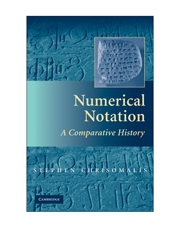Book contents
- Frontmatter
- Contents
- Acknowledgments
- 1 Introduction
- 2 Hieroglyphic Systems
- 3 Levantine Systems
- 4 Italic Systems
- 5 Alphabetic Systems
- 6 South Asian Systems
- 7 Mesopotamian Systems
- 8 East Asian Systems
- 9 Mesoamerican Systems
- 10 Miscellaneous Systems
- 11 Cognitive and Structural Analysis
- 12 Social and Historical Analysis
- 13 Conclusion
- Glossary
- Bibliography
- Index
1 - Introduction
Published online by Cambridge University Press: 18 May 2010
- Frontmatter
- Contents
- Acknowledgments
- 1 Introduction
- 2 Hieroglyphic Systems
- 3 Levantine Systems
- 4 Italic Systems
- 5 Alphabetic Systems
- 6 South Asian Systems
- 7 Mesopotamian Systems
- 8 East Asian Systems
- 9 Mesoamerican Systems
- 10 Miscellaneous Systems
- 11 Cognitive and Structural Analysis
- 12 Social and Historical Analysis
- 13 Conclusion
- Glossary
- Bibliography
- Index
Summary
The Western world is a world of written numbers. One can hardly imagine an industrial civilization functioning without the digits 0 through 9 or a similar system. Yet while these digits have pervasive social and cognitive effects, many unanswered questions remain concerning how humans use numerals. Why do societies enumerate? How does the representation of numbers today differ from their representation in the past? Why does the visual representation of number figure so prominently in complex states? What cognitive and social functions are served by numerical notation systems? How do numeral systems spread from society to society, and how do they change when they do so? And, despite their present ubiquity, why have the vast majority of human societies not possessed them at all?
If you look up from this page and examine your surroundings, I am certain that you will encounter at least one instance of numerical notation, probably more. Moreover, unless you have a Roman numeral clock nearby, I am nearly certain that all of the numerals you encounter are those of the Hindu-Arabic or Western system. Numerals serve a wide variety of functions: denotation – “Call George, 876–5000”; computation – “21.00 × 1.15 = 24.15”; valuation – “25 cents”; ordination –”. Wash dishes, 2. Sweep fl oor, 3. Finish manuscript”; and so on. Most of the thousands of numerals we see each day barely register on our conscious minds; regardless, we encounter far more written numbers in our lifetime than we do sunsets, songs, or smiles. Until the past few centuries, the opposite was true for most people.
- Type
- Chapter
- Information
- Numerical NotationA Comparative History, pp. 1 - 33Publisher: Cambridge University PressPrint publication year: 2010

